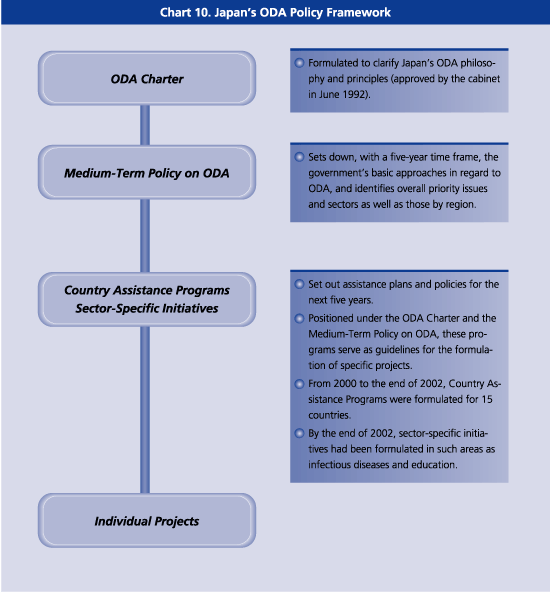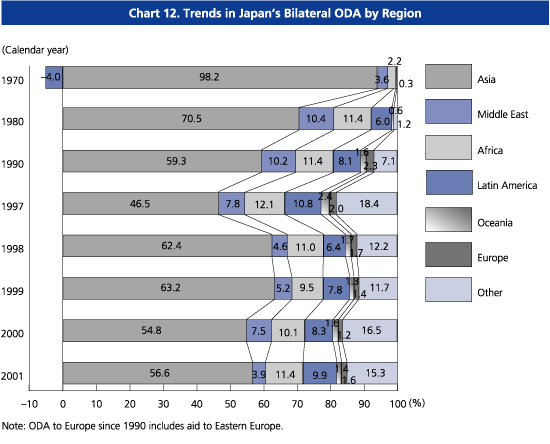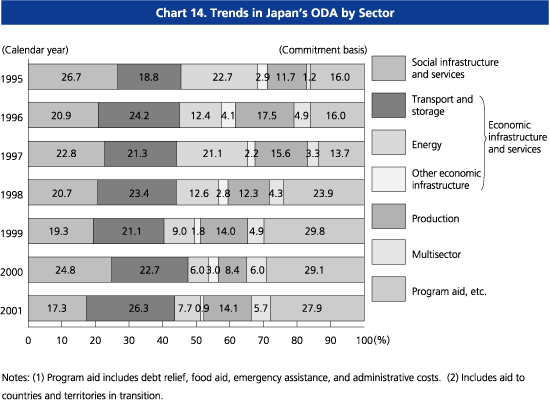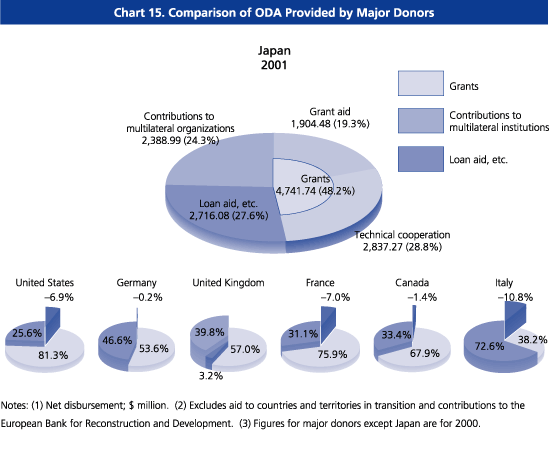Official Development Assistance (ODA)
Japan's ODA White Paper 2002
Part I. Trends in Japan's ODA in a Rapidly Changing World
Chapter 2
Strategic Development of Japan's ODA
As previously mentioned, international concern about development issues is growing. This, along with domestic reactions to official development assistance, has made it imperative that Japan articulate its ODA strategy more clearly by defining its focus and order of priorities in order to utilize limited ODA resources more effectively.
To sum up, Japan's ODA is characterized by its regional focus on Asia and by a development approach that emphasizes poverty reduction through economic growth, human resources development, and institution building while respecting the self-help efforts (ownership) of developing countries. In implementing development cooperation, it is important that Japan make full use of its experience and know-how. Recently, Japan is attaching great importance to endeavors toward the achievement of the Millennium Development Goals (MDGs) and other international targets, and is also actively using ODA in new undertakings to promote peace and stability.
This chapter describes the general characteristics of Japan's ODA. This is followed by an analysis of ODA strategies by region and a description of efforts toward peace building--including the consolidation of peace and nation building--an area in which ODA is expected to be increasingly utilized from now on. Also addressed in this chapter are Japanese efforts to promote human security--a priority issue for Japan--and to achieve the MDGs, as well as to strengthen international collaboration, which is becoming more important.
Section 1. Overview of Japan's ODA
Key Points
- From a regional perspective, Japan's ODA is focused on Asia. In terms of its development strategy, Japan emphasizes poverty reduction through economic growth, human resources development, and institution building.
- Japan also attaches great importance to new endeavors, such as the use of ODA for the consolidation of peace and stability, human security, and the achievement of the Millennium Development Goals.
Basic Framework for ODA Policy
In 1992 Japan established and published the ODA Charter, which describes the Basic Philosophy, Principles, Priority Issues and Regions, and other aspects of its ODA. The ODA Charter contains concepts like "a humanitarian viewpoint," "interdependence," "environmental conservation," and Japan's mission "as a peace-loving nation" and calls for the implementation of ODA to achieve sound economic development through support for the self-help efforts of developing countries.
In 1999 the government established and published its Medium-Term Policy on ODA. Based on the ODA Charter, the Medium-Term Policy sets the direction for Japan's development policies and programs over a period of around five years. The Medium-Term Policy sets poverty reduction as the main objective of development assistance, principally by promoting economic growth. While there is a growing trend toward aid coordination among donor and recipient countries, international organizations, NGOs, and other bodies, the Medium-Term Policy gives top priority to assistance for poverty alleviation programs, social development, human resources development, and responses to global issues while seeking a balance with support for economic and social infrastructure improvements. It also introduces such new elements as the New Development Strategy issued by the OECD-DAC in 1996, an emphasis on human security, the promotion of cooperation based on public participation, and the impact of conflicts and disasters on development.
Under these basic policies, Japan has actively formulated assistance plans for specific countries and initiatives for priority sectors. These include Country Assistance Programs,4 which define Japan's aid objectives, priority sectors, and other aspects of assistance to major recipients, and initiatives targeting specific sectors and issues, such as infectious diseases and the environment.
In December 2002 the Ministry of Foreign Affairs (MOFA) announced a review of the ODA Charter as part of the process of ODA reform. The review will take into account changes in the domestic and international situation over the 10 years since the Charter was established.
Characteristics of Japan's ODA by Region, Sector, and Scheme Of Japan's ODA disbursements in 2001, $4.2 billion, or about 60% of total bilateral assistance, was allocated to Asia. The emphasis on Asia is a basic policy of Japan's ODA and is explicitly stated in both the ODA Charter and the Medium-Term Policy. Though actual amounts have varied from year to year, the focus on Asia has consistently been the biggest characteristic of Japan's ODA.
As for disbursement by sector, economic infrastructure and services accounted for the largest share (34.9%) of ODA, followed by social infrastructure and services (17.3%). Half of Japan's ODA is devoted to these two sectors. Japan has traditionally been active in the area of economic infrastructure improvement, primarily through yen loans. In addition to this type of support for economic growth, Japan is increasing its support in the social sector, including public health and education. This is a reflection of a growing trend in the international community toward direct support for poverty problems. Japan emphasizes support for both the economic and social sectors in its ODA.
As for disbursement by scheme, bilateral ODA accounted for three-fourths of Japan's assistance in 2001, with multilateral aid accounting for the remainder. As indicated by these figures, bilateral ODA is the core scheme, the reason being that by designing its own assistance projects, Japan can better achieve its policy objectives and ensure the "visibility of Japanese aid." There are, of course, certain advantages to providing ODA through international organizations: They can deliver better assistance when bilateral approaches present difficulties, especially emergency humanitarian assistance, and the skills and expertise they possess can be put to active use.
Grant aid accounts for about one-fourth of Japan's bilateral ODA, the rest being split roughly evenly between technical cooperation and yen loans. About 70% of loans are provided for improvements in economic infrastructure, which, in recent years, have diversified to include human resources development and poverty alleviation programs.
4. Programs have been formulated for 15 countries as of December 2002.
As China undergoes a process of rapid economic growth, the gap in wealth between the country's coastal areas and inland regions has widened. In order to rectify this disparity, the Chinese Government has adopted a policy to develop human resources by reinforcing inland higher education institutions. Since joining the World Trade Organization (WTO), China has been trying to strengthen its relationship with the global economy by advancing an openness and reform policy. To that end, China urgently needs to foster human resources who are well versed in the rules of the market economy in such areas as information technology, finance, public finance, accounting, and law. The Chinese government has put emphasis on expanding tertiary education, setting a target for an enrollment rate of around 15% at tertiary education institutions by 2005 in its 10th Five-Year Plan.
In this context, in fiscal year 2001 Japan provided the first yen loan (approximately ¥30 billion) for human resources development in China through the Japan Bank for International Cooperation (JBIC). The loan project is to provide both "hard support" and "soft support" to 64 universities in six inland areas (Shaanxi, Gansu, Sichuan, Yunnan, and Hunan Provinces and Chongqing City).
The "hard support" includes the construction and rehabilitation of school buildings and libraries, the construction of language laboratories, the improvement of facilities for research and experimentation, and the establishment of information and communication networks. The "soft support" is principally to provide the faculty of those Chinese universities training and research programs held at universities in Japan.
Future assistance is expected to include the introduction of educational and research equipment and systems utilizing Japanese experience and technology at China's inland universities and colleges and the promotion of exchanges between educational institutions in the two countries. It is hoped that these projects will contribute to expanding interaction between Japan and China.






